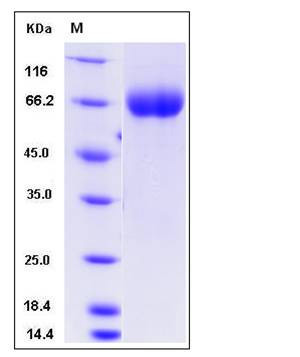Mouse ROBO4 Protein (His Tag)
1200012D01Rik,AI593217
- 100ug (NPP3460) Please inquiry
| Catalog Number | P51081-M08H |
|---|---|
| Organism Species | Mouse |
| Host | Human Cells |
| Synonyms | 1200012D01Rik,AI593217 |
| Molecular Weight | The secreted recombinant mouse ROBO4 (aa 1-480) comprises 454 amino acids and has a calculated molecular mass of 49.6 kDa. As a result of glycosylation, the apparent molecular mass of the recombinant protein is approximately 65 kDa in SDS-PAGE under reducing conditions. |
| predicted N | Leu 38 |
| SDS-PAGE |  |
| Purity | > 97 % as determined by SDS-PAGE |
| Protein Construction | A DNA sequence encoding the mouse ROBO4 (NP_083059.2) N-terminal fragment (Met 1-Glu 480) was expressed, with a C-terminal polyhistidine tag. |
| Bio-activity | |
| Research Area | Immunology |Signal Transduction |Cytoskeleton / ECM |Extracellular Matrix |
| Formulation | Lyophilized from sterile PBS, pH 7.4 1. Normally 5 % - 8 % trehalose, mannitol and 0.01% Tween80 are added as protectants before lyophilization. Specific concentrations are included in the hardcopy of COA. |
| Background | Roundabout homolog 4, also known as magic roundabout and ROBO4 is a member of the immunoglobulin superfamily and ROBO family. ROBO4 is specifically expressed in endothelial cells. It is expressed at sites of angiogenesis in different tumor types. ROBO4 contains two fibronectin type-III domains and two Ig-like C2-type (immunoglobulin-like) domains. ROBO4 is the fourth identified member of the roundabout receptor family. It is the only Robo family member expressed in primary endothelial cells and that application of Slit inhibits their migration. ROBO4 is predominantly expressed in embryonic or tumor vascular endothelium and is considered important for vascular development and as a candidate tumor endothelial marker. ROBO4 is a bona fide member of the Robo family and may provide a repulsive cue to migrating endothelial cells during vascular development. ROBO4 is a receptor for Slit proteins, at least for SLIT2, and seems to be involved in angiogenesis and vascular patterning. ROBO4 may mediate the inhibition of primary endothelial cell migration by Slit proteins. Activating ROBO4 may have broad therapeutic application in diseases characterized by excessive angiogenesis and/or vascular leak. |
| Reference |
